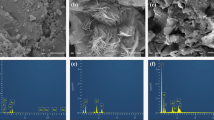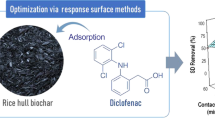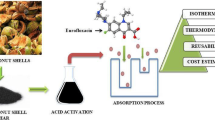Abstract
Untreated rice husk (RH) was evaluated as solid-phase extraction (SPE) sorbent for Fluoroquinolone antibiotics (FQs). This natural material, made of cellulose, hemicellulose, lignin and silica, and containing various functional groups, i.e., carboxyl, hydroxyl, and amidogen residues, is a potential sorbent material for polar aromatics like FQs. First, the RH capability to adsorb FQ species from water was studied by batch sorption experiments in tap and river waters, and the experimental data, fitted by the Langmuir model, gave adsorption capacities up to 32 mg g−1. Then, RH was tested as column-packed sorbent for pre-concentration of tap and not tampered river waters spiked with six widely employed FQs, i.e., Ciprofloxacin, Danofloxacin, Enrofloxacin, Levofloxacin, Marbofloxacin, and Norfloxacin. The analytes were quantitatively adsorbed on the RH cartridge at the native pH, simultaneously eluted by NH3–MeOH mixture, separated in an 8 min ultrahigh-performance liquid chromatography run and quantified/confirmed by electrospray ionization tandem mass spectrometric detection in single reaction monitoring mode. Recoveries in the range 71–120% were observed (RSD < 15%, n = 3) for 75–1000 ng L−1 spikes. Method detection limits were in the range 25–33 ng L−1. The batch-to-batch reproducibility was assessed, and the analytical procedure was applied to the determination of FQs in actual environmental waters.


Similar content being viewed by others
References
Crini G, Badot PM (2010) Sorption processes and pollution: conventional and non-conventional sorbents for pollutant removal from wastewater. Presses Universitaires de Franche-Comté, Besançon
Ali I, Asim M, Khan TA (2012) J Environ Management 113:170–183
Akhtar M, Bhanger MI, Iqbal S, Hasany SM (2006) J Hazard Mater 128:44–52
Foo KY, Hameed BH (2009) Adv Colloid Interface Sci 152:39–47
Chowdhury S, Mishra R, Saha P, Kushwaha P (2011) Desalination 265:159–168
Chuah TG, Jumasiah A, Azni I, Katayon S, Choong SYT (2005) Desalination 175:305–316
Chakraborty S, Chowdhury S, Das Saha P (2011) Carbohydr Polym 86:1533–1541
Safa Y, Bhatti HN (2011) Desalination 272:313–322
Gautam RK, Mudhoo A, Lofrano G, Chattopadhyaya MC (2014) J Environ Chem Eng 2:239–259
Dalai C, Jha R, Desai VR (2015) Aquatic Procedia 4:1126–1133
Ashrafi SD, Kamani H, Jaafari J, Mahvi AH (2016) Desalin Water Treat 57:16456–16465
Reemtsma T, Jekel M (2006) Organic pollutant in the water cycle. Wiley-VCH, Weinheim
Sturini M, Speltini A, Maraschi F, Pretali L, Profumo A, Fasani E, Albini A, Migliavacca R, Nucleo E (2012) Water Res 46:5575–5582
Sturini M, Speltini A, Maraschi F, Pretali L, Ferri EN, Profumo A (2015) Chemosphere 134:313–318
Lillenberg M, Yurchenko S, Kipper K, Herodes K, Pihl V, Sepp K, Lõhmus R, Nei L (2009) J Chromatogr A 1216:5949–5954
Speltini A, Sturini M, Maraschi F, Viti S, Sbarbada D, Profumo A (2015) J Chromatogr A 1410:44–50
Speltini A, Sturini M, Maraschi F, Profumo A (2010) J Sep Sci 33:1115–1131
Speltini A, Sturini M, Maraschi F, Profumo A, Albini A (2011) Trends Anal Chem 30:1337–1350
Van Doorslaer X, Dewulf J, Van Langenhove H, Demeestere K (2014) Sci Total Environ 500–501:250–269
Speltini A, Sturini M, Maraschi F, Consoli L, Zeffiro A, Profumo A (2015) J Chromatogr A 1379:9–15
Kusari S, Prabhakaran D, Lamshöft M, Spiteller M (2009) Environ Pollut 157:2722–2730
Sukul P, Lamshöft M, Kusari S, Zühlke S, Spiteller M (2009) Environ Res 109:225–231
Sirtori C, Zapata A, Gernjak W, Malato S, Agüera A (2012) Chemosphere 88:627–634
Dorival-García N, Zafra-Gómez A, Cantarero S, Navalón A, Vílchez JL (2013) Microchem J 106:323–333
Speltini A, Sturini M, Maraschi F, Porta A, Profumo A (2016) Talanta 147:322–327
Vazquez-Roig P, Segarra R, Blasco C, Andreu V, Picó Y (2010) J Chromatogr A 1217:2471–2483
Chen B, Wang W, Huang Y (2012) Talanta 88:237–243
Song ST, Saman N, Johari K, Mat H (2014) Clean Techn Environ Policy 16:1747–1755
Sturini M, Speltini A, Pretali L, Fasani E, Profumo A (2009) J Sep Sci 32:3020–3028
Xu S, Jiang C, Lin YX, Jia L (2012) Microchim Acta 179:257–264
Huang XJ, Wang YL, Liu Y, Yuan DX (2013) J Sep Sci 36:3210–3219
Speltini A, Sturini M, Maraschi F, Mandelli E, Vadivel D, Dondi D, Profumo A (2016) Microchim Acta 183:2241–2249
Mei M, Huang X (2016) J Sep Sci 39:1908–1918
Acknowledgments
The authors want to thank Elisa Rivagli for her contribution to the present work.
Author information
Authors and Affiliations
Corresponding author
Ethics declarations
Conflict of interest
The authors declare no conflict of interest.
Electronic supplementary material
Below is the link to the electronic supplementary material.
Rights and permissions
About this article
Cite this article
Maraschi, F., Speltini, A., Sturini, M. et al. Evaluation of Rice Husk for SPE of Fluoroquinolones from Environmental Waters Followed by UHPLC-HESI-MS/MS. Chromatographia 80, 577–583 (2017). https://doi.org/10.1007/s10337-017-3272-8
Received:
Revised:
Accepted:
Published:
Issue Date:
DOI: https://doi.org/10.1007/s10337-017-3272-8




